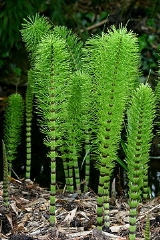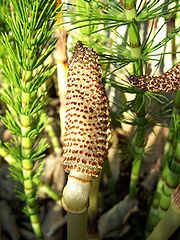
Equisetum telmateia
Encyclopedia
Equisetum telmateia is a species of Equisetum (horsetail) with an unusual distribution, with one subspecies
native to Europe
, western Asia
and northwest Africa
, and a second subspecies native to western North America
. The North American subspecies
is often simply but ambiguously called "giant horsetail", but that name may just as well refer to the Latin America
n Equisetum giganteum
and Equisetum myriochaetum
.
 It is a herbaceous
It is a herbaceous
perennial plant
, with separate green photosynthetic
sterile stems, and pale yellowish non-photosynthetic spore
-bearing fertile stems. The sterile stems, produced in late spring and dying down in late autumn, are 30–150 cm (rarely to 240 cm) tall (the tallest species of horsetail outside of tropical regions) and 1 cm diameter, heavily branched, with whorls of 14–40 branches, these up to 20 cm long, 1–2 mm diameter and unbranched, emerging from the axils of a ring of bract
s. The fertile stems are produced in early spring before the sterile shoots, growing to 15–45 cm tall with an apical spore-bearing strobilus
4–10 cm long and 1–2 cm broad, and no side branches; the spores disperse in mid spring, with the fertile stems dying immediately after spore release. It also spreads by means of rhizomes that have been observed to penetrate 4 meters into wet clay soil, spreading laterally in multiple layers. Occasional plants produce stems that are both fertile and photosynthetic.
It is found in damp shady places, spring fen
s and seepage lines, usually in open woodlands, commonly forming large clonal colonies
.
There are two subspecies:
Subspecies
Subspecies in biological classification, is either a taxonomic rank subordinate to species, ora taxonomic unit in that rank . A subspecies cannot be recognized in isolation: a species will either be recognized as having no subspecies at all or two or more, never just one...
native to Europe
Europe
Europe is, by convention, one of the world's seven continents. Comprising the westernmost peninsula of Eurasia, Europe is generally 'divided' from Asia to its east by the watershed divides of the Ural and Caucasus Mountains, the Ural River, the Caspian and Black Seas, and the waterways connecting...
, western Asia
Asia
Asia is the world's largest and most populous continent, located primarily in the eastern and northern hemispheres. It covers 8.7% of the Earth's total surface area and with approximately 3.879 billion people, it hosts 60% of the world's current human population...
and northwest Africa
Africa
Africa is the world's second largest and second most populous continent, after Asia. At about 30.2 million km² including adjacent islands, it covers 6% of the Earth's total surface area and 20.4% of the total land area...
, and a second subspecies native to western North America
North America
North America is a continent wholly within the Northern Hemisphere and almost wholly within the Western Hemisphere. It is also considered a northern subcontinent of the Americas...
. The North American subspecies
Subspecies
Subspecies in biological classification, is either a taxonomic rank subordinate to species, ora taxonomic unit in that rank . A subspecies cannot be recognized in isolation: a species will either be recognized as having no subspecies at all or two or more, never just one...
is often simply but ambiguously called "giant horsetail", but that name may just as well refer to the Latin America
Latin America
Latin America is a region of the Americas where Romance languages – particularly Spanish and Portuguese, and variably French – are primarily spoken. Latin America has an area of approximately 21,069,500 km² , almost 3.9% of the Earth's surface or 14.1% of its land surface area...
n Equisetum giganteum
Equisetum giganteum
Equisetum giganteum is a species of horsetail native to South America and Central America, from central Chile east to Brazil and north to southern Mexico....
and Equisetum myriochaetum
Equisetum myriochaetum
Equisetum myriochaetum, also known as Mexican Giant Horsetail, is a species of horsetail that is native to Nicaragua, Costa Rica, Colombia, Venezuela, Ecuador, Peru and Mexico....
.

Herbaceous
A herbaceous plant is a plant that has leaves and stems that die down at the end of the growing season to the soil level. They have no persistent woody stem above ground...
perennial plant
Perennial plant
A perennial plant or simply perennial is a plant that lives for more than two years. The term is often used to differentiate a plant from shorter lived annuals and biennials. The term is sometimes misused by commercial gardeners or horticulturalists to describe only herbaceous perennials...
, with separate green photosynthetic
Photosynthesis
Photosynthesis is a chemical process that converts carbon dioxide into organic compounds, especially sugars, using the energy from sunlight. Photosynthesis occurs in plants, algae, and many species of bacteria, but not in archaea. Photosynthetic organisms are called photoautotrophs, since they can...
sterile stems, and pale yellowish non-photosynthetic spore
Spore
In biology, a spore is a reproductive structure that is adapted for dispersal and surviving for extended periods of time in unfavorable conditions. Spores form part of the life cycles of many bacteria, plants, algae, fungi and some protozoa. According to scientist Dr...
-bearing fertile stems. The sterile stems, produced in late spring and dying down in late autumn, are 30–150 cm (rarely to 240 cm) tall (the tallest species of horsetail outside of tropical regions) and 1 cm diameter, heavily branched, with whorls of 14–40 branches, these up to 20 cm long, 1–2 mm diameter and unbranched, emerging from the axils of a ring of bract
Bract
In botany, a bract is a modified or specialized leaf, especially one associated with a reproductive structure such as a flower, inflorescence axis, or cone scale. Bracts are often different from foliage leaves. They may be smaller, larger, or of a different color, shape, or texture...
s. The fertile stems are produced in early spring before the sterile shoots, growing to 15–45 cm tall with an apical spore-bearing strobilus
Strobilus
A strobilus is a structure present on many land plant species consisting of sporangia-bearing structures densely aggregated along a stem. Strobili are often called cones, but many botanists restrict the use of the term cone to the woody seed strobili of conifers...
4–10 cm long and 1–2 cm broad, and no side branches; the spores disperse in mid spring, with the fertile stems dying immediately after spore release. It also spreads by means of rhizomes that have been observed to penetrate 4 meters into wet clay soil, spreading laterally in multiple layers. Occasional plants produce stems that are both fertile and photosynthetic.
It is found in damp shady places, spring fen
Fen
A fen is a type of wetland fed by mineral-rich surface water or groundwater. Fens are characterised by their water chemistry, which is neutral or alkaline, with relatively high dissolved mineral levels but few other plant nutrients...
s and seepage lines, usually in open woodlands, commonly forming large clonal colonies
Clonal colony
A clonal colony or genet is a group of genetically identical individuals that have grown in a given location, all originating vegetatively from a single ancestor. In plants, an individual in such a population is referred to as a ramet...
.
There are two subspecies:
- Equisetum telmateia subsp. telmateia. Great Horsetail. Europe, western Asia, northwest Africa. Main stem between branch whorls pale greenish white.
- Equisetum telmateia subsp. braunii (Milde) Hauke. Northern Giant Horsetail. Western North America, from southeastern AlaskaAlaskaAlaska is the largest state in the United States by area. It is situated in the northwest extremity of the North American continent, with Canada to the east, the Arctic Ocean to the north, and the Pacific Ocean to the west and south, with Russia further west across the Bering Strait...
and western British ColumbiaBritish ColumbiaBritish Columbia is the westernmost of Canada's provinces and is known for its natural beauty, as reflected in its Latin motto, Splendor sine occasu . Its name was chosen by Queen Victoria in 1858...
south to CaliforniaCaliforniaCalifornia is a state located on the West Coast of the United States. It is by far the most populous U.S. state, and the third-largest by land area...
. Main stem between branch whorls green.

